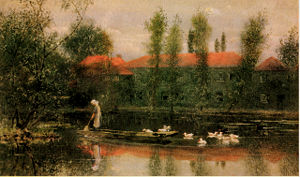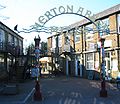- Merton Abbey Mills
-
 The Pond at Merton Abbey by Lexden Lewis Pocock is an idyllic representation of the works in the time of William Morris.[1]
The Pond at Merton Abbey by Lexden Lewis Pocock is an idyllic representation of the works in the time of William Morris.[1]
Merton Abbey Mills is a former textile factory in the parish of Merton in London, England near the site of the medieval Merton Priory, now the home of a variety of businesses, mostly retailers.
The River Wandle flowing north towards Wandsworth drove watermills and provided water for a number of industrial processes in Merton. Merton Abbey Mills were established by Huguenot silk throwers in the early eighteenth century; there were already textile works nearby from 1667.[2] The Abbey was restructured for textile printing in the early nineteenth century and was acquired by the Pre-Raphaelite artist and textile designer William Morris in June 1881 as the new home of Morris & Co.'s workshops. The complex, on 7 acres (28,000 m2), included several buildings and a dyeworks, and the various buildings were soon adapted for stained glass making, textile printing, and fabric, tapestry, and carpet-weaving.[3] Morris refused to destroy existing buildings, and adapted them or built new ones.[4]
Morris employed a number of former Spitalfields silk weavers at Merton Abbey to produce hand-woven textiles, and used the gardens to grow dye plants and the water of the River Wandle to dye and rinse his fabrics.[5]
Liberty & Co. had been involved with the site since the 19th century, as their popular ranges of fabrics for dress and furniture were nearly all made there by Littler and Co, Morris's immediate neighbours to the south. In 1904 Liberty & Co took over the Littler site, and then in 1940 the Morris facilities as well. They continued to operate the Merton Abbey Mills until 1972, and textile production was continued by other firms until 1982. During World War II part of the site was used to construct gun-turrets for the Bristol Blenheim fighter-bomber.[6]
Today Merton Abbey Mills is a crafts market and the site of a summer theatre and music festival called Abbeyfest. A number of buildings from the Morris period, and even earlier, survive, and there are displays on the history of the site. A water-mill still turns in the summer, and the "colourhouse", a mid-18th century industrial building,[6] is now a children's theatre.
See also
Notes
- ^ For a modern view from a slightly different spot, see the 2nd photo here
- ^ History of Merton Priory
- ^ Parry, William Morris, p. 57
- ^ Merton Priory - Morris & Co
- ^ Wilhide, p. 30-31.
- ^ a b Merton Priory - Calico
- ^ Naylor, p. 204
References
- Fairclough, Oliver and Emmeline Leary, Textiles by William Morris and Morris & Co. 1861-1940, Birmingham Museums and Art Gallery, 1981, ISBN 0-89860-065-0
- Naylor, Gillian, William Morris by Himself: Designs and Writings, London, Little Brown & Co. 2000 reprint of 1988 edition, ISBN 0316855073
- Parry, Linda, "Textiles", in The Earthly Paradise: Arts and Crafts by Wiliam Morris and his Circle in Canadian Collections, edited by Katharine A. Lochnan, Douglas E. Schoenherr, and Carole Silver, Key Porter Books, 1993, ISBN 1-55013-450-7
- Parry, Linda, ed., William Morris, Abrams, 1996, ISBN 0-8109-4282-8
- Parry, Linda, William Morris and the Arts and Crafts Movement: A Sourcebook, New York, Portland House, 1989 ISBN 0-517-69260-0
- Parry, Linda, William Morris Textiles, New York, Viking Press, 1983, ISBN 0-670-77074-4
- Parry, Linda, Textiles of the Arts & Crafts Movement, Thames and Hudson, revised edition 2005, ISBN 0-500-28536-5
- Wilhide, Elizabeth, William Morris and the Art of Design New York, Abrams, 1991, ISBN0810936232
External links
- Merton Abbey Mills official site - designed and maintained by www.angleseydesign.co.uk and hosted by www.jenlu.com
- Abbeyfest
- Merton Priory Trust - full notes on the history and archaeology by David Saxby of the Museum of London
Categories:- Textile arts
- History of Merton
- Morris & Co.
Wikimedia Foundation. 2010.







